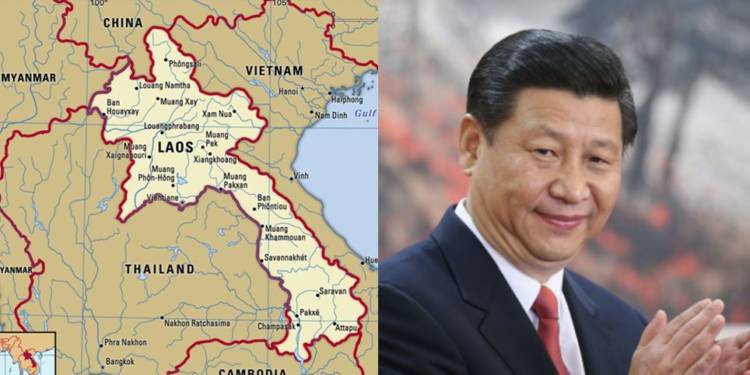The international community has stayed really splintered when it comes to taking on the irresponsible foreign policy approach of China under Xi Jinping. Beijing has profited off of it enormously. Take for example the situation in Laos, everyone is aware of the way in which China has succeeded in carving out the country all for themselves right under the ASEAN’s nose. Now with the completion of the impractical high-speed railway project, coupled with socio-economic vulnerabilities, China has finally stamped its authority over the country as a colony.
The debut of a high-speed train to China, promoted as a growth engine for the impoverished Southeast Asian country and a fresh path for Beijing to expand its reach deeper into the region, has been overshadowed by the spread of Covid-19 infections in the country. This has provided the administration of the one-party communist state to limit the train’s ridership on its inaugural run on Friday to officials, thereby diffusing any chances of protests by the Laos civilians.
The people of Laos in the recent past have been forced fed Chinese culture, in bordering regions they are being used as forced labour, and to top it all off, the government of Laos has entirely sold out to the Chinese Communist Party. And while all this was going on, except Vietnam and Japan, no other country gave enough importance to it and now there is no going back.
The project in detail: Laotian only in name
The project has become a glaring reminder of Laos’ drowning under the weight of Chinese loans in its haste to build big-ticket infrastructure in the five years since it began. An estimated 60% of the high-speed railway’s cost, or $3.6 billion, was covered by a loan from China’s Export-Import Bank. The remaining 40% has been covered by the Lao-China Railway Company, a joint venture between the two countries. However, China owns a 70% stake in the enterprise, with Laos contributing $250 million from the state budget and $450 million from an Export-Import Bank loan.
“The pro-Vietnamese faction expressed some dissatisfaction, while the pro-China faction backed the initiative,” a Laotian expert stated. Former Deputy Prime Minister Somsavat Lengsavad, a competent Mandarin speaker of Chinese ancestry, led the pro-China faction. The route from Vientiane to Boten, a northern frontier town on the Laos-China border, will cut a two-day road trip through tough mountain terrain down to just three hours. The Lane Xang, named after an ancient Laotian kingdom, would move at a top speed of 160 kilometres per hour through 75 tunnels and 167 bridges.
China’s debt-trap diplomacy in Laos in face of a silent International community
According to the World Bank, Laos’ $19.14 billion GDP accumulated an extra $13.3 billion in debt last year. Fitch Ratings cautioned in August that the country will confront severe debt payment commitments of $1.16 billion per year from 2022 to 2025, half of which would be owing to China. The country’s foreign reserves were $1.2 billion in May, compared to $1.32 billion at the end of 2020.
Laos’ need for foreign earnings to repay its debt has been exacerbated by China’s strict COVID-19 border controls. The inaugural train runs this week serves as a reminder: Laotian officials had hoped that the bullet train, as well as the entry of Chinese visitors from Yunnan Province, on the other end of the route, would assist the country’s economy. While depending on the promise of the arrival of the Chinese tourists with huge pockets is childish itself, the lockdown in China has shattered even this hope.
While these big promises were just to sell the project as an economic solution to Laos’s problems, but in reality, it was to make sure that the country becomes entirely dependent on China, and become the colonial extension of the Chinese imperial intentions.
Laos: China’s Neo-colonial enterprise
Highways between the two countries have been upgraded since the end of the Cold War, notably in the last decade, supercharging the old mule commerce routes and smuggling trails that once connected the Lao principalities to what is now southern China. These have now been complemented by the construction of a new railway connecting Vientiane with China’s Yunnan region, which is set to open in December.
Also read: After unleashing coronavirus in the world, China is preparing to starve Laos, Vietnam and Cambodia
As a result of this integration, Chinese immigration to Laos has increased dramatically, particularly in Vientiane and the northern province capitals. Given the country’s limited legal structure and the political sensitivity surrounding Chinese migration, estimates vary, but one estimate puts the number of Chinese expatriates in Laos at 300,000. This is the most basic yet effective way to control a nation and convert it into a colony by inducing demographic changes.
Late last year, Laos became the latest victim of the Chinese debt trap as after strategically dehydrating the country and burying it under unsustainable Chinese loans, China occupied the country’s national power grid after Laos was struggling to avoid defaulting on Chinese debt. In a worrying development, Laos ceded majority control of its electric grid to a Chinese company as the country struggled to avoid a default on Chinese debt.
While these developments were followed by attempts from Vietnam and Japan, to bring the country out of China’s perpetual dependence. However, with the launch of the high-speed train, with no economic incentive in the sight, Laos has finally turned into a total Chinese colony with neo-colonial characteristics.
